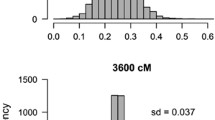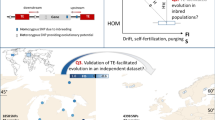Abstract
Marker-based studies of inbreeding may lead to an enhanced understanding of inbreeding depression in natural populations, which is a major concern in conservation genetics. Correlations between marker heterozygosity and variation in fitness-associated traits—‘heterozygosity-fitness correlations’ (HFCs)—are of particular importance and have been widely applied in natural populations. In partially inbred populations, HFCs can be driven by selection against inbred individuals and thus reflect inbreeding depression. However, other explanations for HFCs also exist, such as functional effects of the markers per se or that the markers reveal selection on linked fitness genes due to extended linkage disequilibrium (LD) in the population. Accordingly, HFCs do not only arise in partially inbred populations, they may also occur within inbreeding classes such as families, i.e. in situations when there is no variation in the inbreeding coefficient. In this study we focus on the importance of LD for within-family HFCs, thereby aiming at enhancing our general understanding of HFCs. For non-coding markers, within-family HFCs have been proposed to be caused in two ways: either by ‘local effects’ at linked fitness genes in LD with the markers, or by ‘general effects’ due to a correlation between proportion of heterozygous markers (H M ) and heterozygosity at genome-wide distributed fitness genes (H GW ). To evaluate these contrasting hypotheses for within-family HFCs, we analysed simulated data sets of sexually reproducing populations with varying levels of LD. The results confirmed that segregation induces variation in both H M and H GW at a fixed level of inbreeding; as expected, the variation in H M declined with increasing number of markers, whereas the variation in H GW declined with decreasing LD. However, less intuitively, there was no positive correlation between the variation in H M and H GW within inbreeding classes when the local component of H GW was accounted for (i.e. when the part of the chromosome in LD with the markers was excluded). This strongly suggests that within-family HFCs are not caused by general effects. Instead, our results support the idea that HFCs at a known level of inbreeding can be driven by local effects in populations with high to moderate LD. Note however that we define the local component of H GW as the part of the chromosomes in LD with the markers. This implies that when LD is high, the local component will consist of a substantial part of the genome and thus provides a rather ‘genome-wide’ view. We caution against routinely interpreting positive HFCs as evidence of inbreeding depression and non-significant HFCs as lack thereof, especially when few markers are used.








Similar content being viewed by others
References
Allendorf FW, Leary RF (1986) Heterozygosity and fitness in natural populations of animals. In: Soulé ME (ed) Conservation biology: the science of scarcity and diversity. Sinauer Associates, Sunderland, Massachusetts, pp 57–76
Balloux F, Amos W, Coulson T (2004) Does heterozygosity estimate inbreeding in real populations? Mol Ecol 13:3021–3031
Bensch S, Andrén H, Hansson B, et al (2006) Selection for heterozygosity gives hope to a wild population of inbred wolves. PLoS One 1:e72
Bierne N, Launey S, Naciri-Graven Y, Bonhomme F (1998) Early effect of inbreeding as revealed by microsatellite analyses on Ostrea edulis larvae. Genetics 148:1893–1906
Bonnell ML, Selander RK (1974) Elephant seals: genetic variation and near to extinction. Science 184:908–909
Britten HB (1996) Meta-analyses of the association between multilocus heterozygosity and fitness. Evolution 50:2158–2164
Brooker MG, Rowley I, Adams M, Baverstock PA (1990) Promiscuity: an inbreeding avoidance mechanism in a socially monogamous species? Behav Ecol Sociobiol 26:191–199
Bustamante CD, Nielsen R, Sawyer SA et al (2002) The cost of inbreeding in Arabidopsis. Nature 416:531–534
Chakraborty R (1981) The distribution of the number of heterozygous loci in an individual in natural populations. Genetics 98:461–466
Chakraborty R, Weiss KM (1988) Admixture as a tool for finding linked genes and detecting that difference from allelic association between loci. Proc Natl Acad Sci U S A 85:9119–9123
Charlesworth D, Charlesworth B (1987) Inbreeding depression and its evolutionary consequences. Annu Rev Ecol Syst 18:237–268
Coltman DW, Pilkington JG, Smith JA, Pemberton JM (1999) Parasite mediated selection against inbred Soay sheep in a free-living, island population. Evolution 53:1259–1267
Coltman DW, Slate J (2003) Microsatellite measures of inbreeding: a meta-analysis. Evolution 57:971–983
Dahlgaard J, Hoffmann AA (2000) Stress resistance and environmental dependency of inbreeding depression in Drosophila melanogaster. Conserv Biol 14:1187–1192
David P (1998) Heterozygosity-fitness correlations: new perspective on old problems. Heredity 80:531–537
Dawson E, Abecasis GR, Bumpstead S et al (2002) A first-generation linkage disequilibrium map of human chromosome 22. Nature 418:544–548
Dermitzakis ET, Clark AG, Batargias C, Magoulas A, Zouros E (1998) Negative covariance suggests mutation bias in a two-locus microsatellite system in the fish Sparus aurata. Genetics 150:1567–1575
Dewoody YD, Dewoody JA (2005) On the estimation of genome-wide heterozygosity using molecular markers. J Hered 96:85–88
Dunning AM, Durocher F, Healey CS et al (2000) The extent of linkage disequilibrium in four populations with distinct demographic histories. Am J Hum Genet 67:1544–1554
Ferreira AG, Amos W (2006) Inbreeding depression and multiple regions showing heterozygote advantage in Drosophila melanogaster exposed to stress. Mol Ecol 15:3885–3893
Foerster K, Delhey K, Johnsen A, Lifjeld JT, Kempenaers B (2003) Females increase offspring heterozygosity and fitness through extra-pair matings. Nature 425:714–717
Ford-Lloyd BV, Newbury HJ, Jackson MT, Virk PS (2001) Genetic basis for co-adaptive gene complexes in rice (Oryza sativaL.) landraces. Heredity 87:530–536
Frankham R, Ballou JD, Briscoe DA (2002) Introduction to conservation genetics. Cambridge University Press, Cambridge
Gage MJ, Surridge AK, Tomkins JL et al (2006) Reduced heterozygosity depresses sperm quality in wild rabbits, Oryctolagus cuniculus. Curr Biol 16:612–617
Groombridge JJ, Jones CG, Bruford MW, Nichols RA (2000) ’Ghost’ alleles of the Mauritius kestrel. Nature 403:616
Hanski I, Saccheri I (2006) Molecular-level variation affects population growth in a butterfly metapopulation. PLoS Biol 4:e129
Hansson B (2003) Dispersal, inbreeding and fitness in natural populations. Lund University, Lund, Sweden
Hansson B, Westerberg L (2002) On the correlation between heterozygosity and fitness in natural populations. Mol Ecol 11:2467–2474
Hansson B, Bensch S, Hasselquist D, Åkesson M (2001) Microsatellite diversity predicts recruitment of sibling great reed warblers. Proc R Soc Lond B 268:1287–1291
Hansson B, Westerdahl H, Bensch S, Hasselquist D, Åkesson M (2004) Does linkage disequilibrium generate heterozygosity-fitness correlations in great reed warblers? Evolution 58:870–879
Hartl DL, Clark AG (1997) Principles of population genetics. Sinauer Associates, Inc., Sunderland, Massachusetts
Hästbacka J, de la Chapelle A, Kaitila I et al (1992) Linkage disequilibrium map** in isolated founder populations: diastrophic dysplasia in Finland. Nature Genet 2:204–211
Houle D (1989) Allozyme-associated heterosis in Drosophila melanogaster. Genetics 123:789–801
Iles MM, Bishop DT (1998) The effect of population structure and mutation rate on linkage disequilibrium. Am J Hum Genet 63:A42
Jarne P, Lagoda PJL (1996) Microsatellites, from molecules to populations and back. Trend Ecol Evol 11:424–429
Kalinowski ST, Hedrick PW (2001) Estimation of linkage disequilibrium for loci with multiple alleles: basic approach and an application using data from bighorn sheep. Heredity 87:698–708
Kashi Y, Soller M (1999) Functional roles of microsatellites and minisatellites. In: Goldstein DB, (ed) Schlötterer C (eds) Microsatellites: evolution and applications. Oxford university press, Oxford, pp. 10–23
Keller LF, Waller DM (2002) Inbreeding effects in wild populations. Trend Ecol Evol 17:230–241
Komdeur J (1994) Conserving the Seychelles warbler Acrocephalus sechellensis by the translocation from Cousin island to the Islands of Aride and Cousine. Biol Conserv 67:143–152
Kruglyak L (1999) Prospects for whole-genome linkage disequilibrium map** of common disease genes. Nature Genet 22:139–144
Leary RF, Allendorf FW, Knudsen KL (1987) Differences in inbreeding coefficients do not explain the association between heterozygosity at allozyme loci and developmental stability in rainbow trout. Evolution 41:1413–1415
Ledig FT (1986) Heterozygosity, heterosis and fitness in outbreeding plants. In: Soulé ME (ed) Conservation biology (The science of scarcity and diversity). Sinauer, New York, pp. 77–104
Ledig FT, Conkle MT, Bermejo-Velázquez B et al (1999) Evidence for an extreme bottleneck in a rare Mexican pinyon: genetic diversity, disequilibrium, and the mating system in Pinus maximartinezii. Evolution 53:91–99
Lynch M, Walsh B (1998) Genetics and analysis of quantitative traits. Sinauer Associates Inc., Sunderland
Madsen T, Shine R, Olsson M, Wittzell H (1999) Restoration of an inbred adder population. Nature 402:34–35
Markert JA, Grant PR, Grant BR et al. (2004) Neutral locus heterozygosity, inbreeding, and survival in Darwin’s ground finches (Geospiza fortis and G. scandens). Heredity 92:306–315
McRae AF, McEwan JC, Dodds KG et al (2002) Linkage disequilibrium in domestic sheep. Genetics 160:1113–1122
Mitton JB (1997) Selection in natural populations. Oxford university press, Oxford, United Kingdom
Nordborg M, Tavaré S (2002) Linkage disequilibrium: what history has to tell us. Trend Genet 18:83–90
Pemberton J (2004) Measuring inbreeding depression in the wild: the old ways are the best. Trend Ecol Evol 19:613–615
Queller DC, Strassmann JE, Hughes CR (1993) Microsatellites and kinship. Trend Ecol Evol 8:285–288
Reich DE, Cargill M, Bolk S et al (2001) Linkage disequilibrium in the human genome. Nature 411:199–204
Reid JM, Arcese P, Keller LF (2003) Inbreeding depresses immune response in song sparrows (Melospiza melodia): direct and inter-generational effects. Proc R Soc Lond B 270:2151–2157
Saccheri I, Kuussaari M, Kankare M et al (1998) Inbreeding and extinction in a butterfly metapopulation. Nature 392:491–494
Sharbel TF, Haubold B, Mitchell-Olds T (2000) Genetic isolation by distance in Arabidopsis thaliana: biogeography and postglacial colonization of Europe. Mol Ecol 9:2109–2118
Sinervo B, Clobert J (2003) Morphs, dispersal behaviour, genetic similarity, and the evolution of cooperation. Science 300:1949–1951
Slate J, David P, Dodds KG et al. (2004) Understanding the relationship between the inbreeding coefficient and multilocus heterozygosity: theoretical expectations and empirical data. Heredity 93:255–265
Slate J, Kruuk LEB, Marshall TC, Pemberton JM, Clutton-Brock TH (2000) Inbreeding depression influences lifetime breeding success in a wild population of red deer (Cervus elaphus). Proc R Soc Lond B 267:1657–1662
Stephens JC, Schneider JA, Tanguay DA et al. (2001) Haplotype variation and linkage disequilibrium in 313 human genes. Science 293:489–493
Sutter NB, Eberle MA, Parker HG et al (2004) Extensive and breed-specific linkage disequilibrium in Canis familiaris. Genome Res 14:2388–2396
Terwilliger JD, Zollner S, Laan M, Paabo S (1998) Map** genes through the use of linkage disequilibrium generated by genetic drift: ’drift map**’ in small populations with no demographic expansion. Hum Hered 48:138–154
Visscher PM, Smith D, Hall SJG, Williams JA (2001) A viable herd of genetically uniform cattle. Nature 409:303
Westemeier RL, Brawn JD, Simpson SA et al. (1998) Tracking the long-term decline and recovery of an isolated population. Science 282:1695–1698
Wright AF, Carothers AD, Pirastu M (1999) Population choice in map** genes for complex diseases. Nat Genet 23:397–404
Yan G, Romero-Severson J, Walton M, Chadee DD, Severson DV (1999) Population genetics of the yellow fever mosquito in Trinidad: comparisons of amplified fragment length polymorphism (AFLP) and restricted fragment length polymorphism (RFLP) markers. Mol Ecol 8:951–963
Zouros E (1993) Associative overdominance: evaluating the effects of inbreeding and linkage disequilibrium. Genetica 89:35–46
Acknowledgments
We are grateful to two anonymous referees for comments and suggestions. This work was supported by a post-doctoral grant from the Swedish Research Council and the Swedish Foundation for International Cooperation in Research and Higher Education (623-2003-191; to BH), a Marie-Curie research fellowship (EC-MEIF-CT-2003-501256; to J. M. Pemberton, University of Edinburgh, and BH) and the Swedish Foundation for Strategic Research (SSF, NGSSC; to LW).
Author information
Authors and Affiliations
Corresponding author
Rights and permissions
About this article
Cite this article
Hansson, B., Westerberg, L. Heterozygosity-fitness correlations within inbreeding classes: local or genome-wide effects?. Conserv Genet 9, 73–83 (2008). https://doi.org/10.1007/s10592-007-9309-z
Received:
Accepted:
Published:
Issue Date:
DOI: https://doi.org/10.1007/s10592-007-9309-z




